Financial Management Assignment: Taxation, Stocks, Ratios
VerifiedAdded on 2023/01/06
|15
|3050
|28
Homework Assignment
AI Summary
This financial management assignment comprehensively addresses key aspects of corporate finance. It begins with the calculation of a corporation's tax liability, including the application of tax rates and surtaxes, and a discussion on the government's social and economic objectives in taxation. The assignment then delves into stock analysis, comparing the risk and return of two stocks using probability distributions, and emphasizes the benefits of diversification in mitigating investment risk. A funding analysis is presented, determining net funding requirements based on balance sheet changes. Ratio analysis is performed on McDonald's Corporation, evaluating its financial position and performance through profitability, liquidity, and activity ratios. Furthermore, the assignment includes a calculation of the future value of an investment and the determination of the Economic Order Quantity (EOQ). It also explores the complexities of international finance, highlighting the management of operational, investment, and financing risks, as well as the significance of functional and reporting currencies. Finally, the assignment concludes with a discussion of financial axioms, including risk-return trade-offs, the time value of money, the importance of cash flow, incremental cash flows, agency problems, tax-biased decisions, and different types of risk.
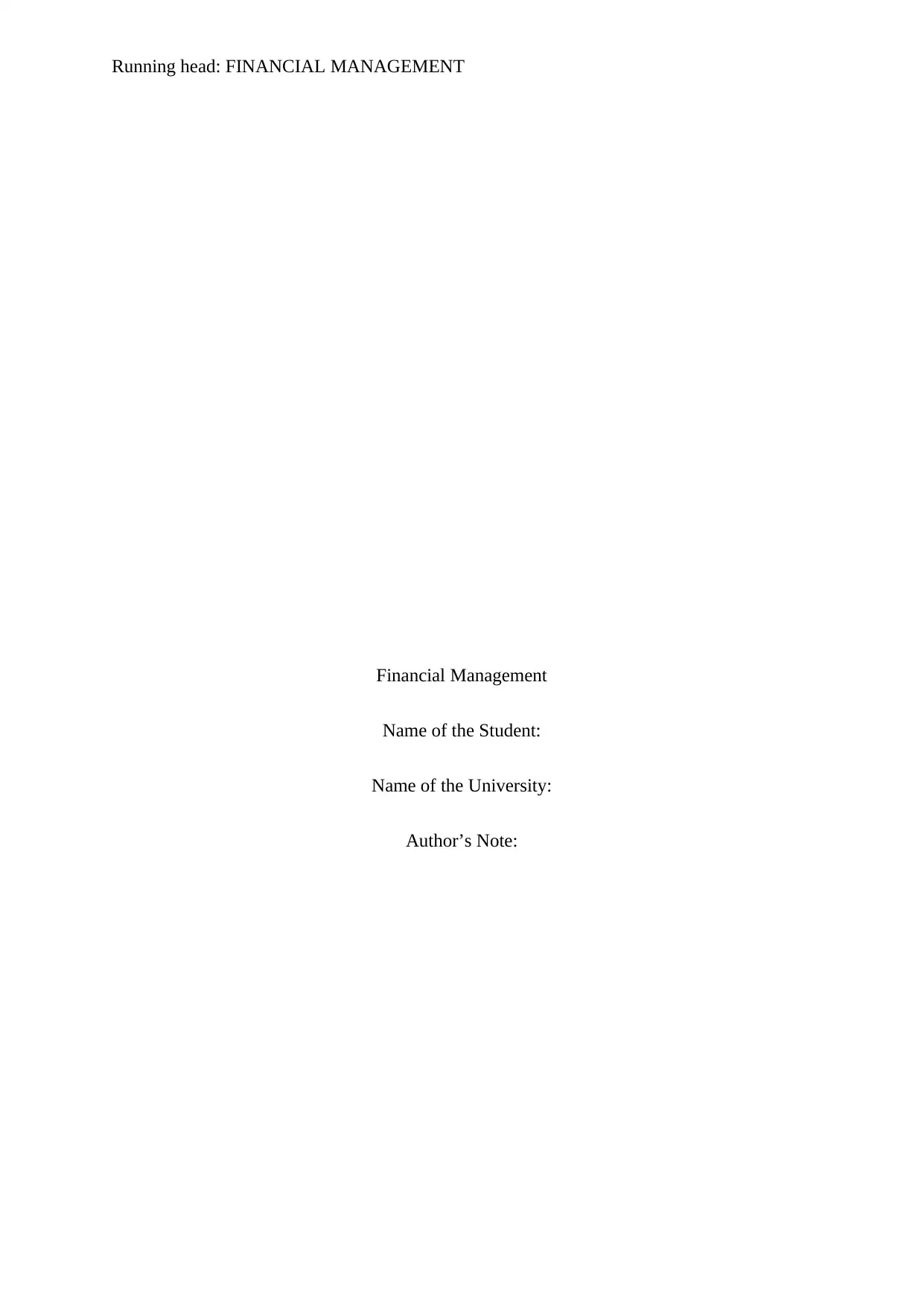
Running head: FINANCIAL MANAGEMENT
Financial Management
Name of the Student:
Name of the University:
Author’s Note:
Financial Management
Name of the Student:
Name of the University:
Author’s Note:
Paraphrase This Document
Need a fresh take? Get an instant paraphrase of this document with our AI Paraphraser
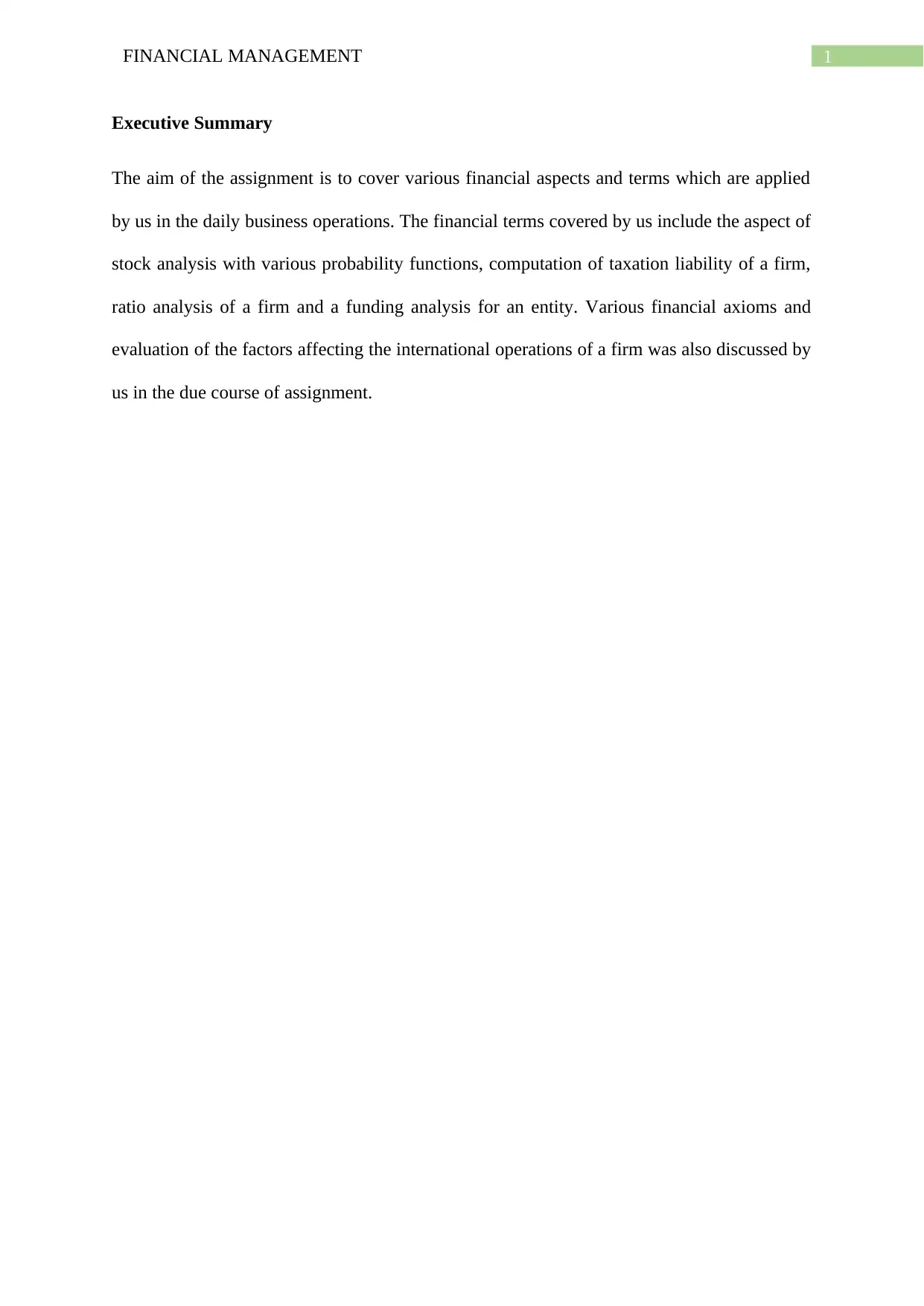
1FINANCIAL MANAGEMENT
Executive Summary
The aim of the assignment is to cover various financial aspects and terms which are applied
by us in the daily business operations. The financial terms covered by us include the aspect of
stock analysis with various probability functions, computation of taxation liability of a firm,
ratio analysis of a firm and a funding analysis for an entity. Various financial axioms and
evaluation of the factors affecting the international operations of a firm was also discussed by
us in the due course of assignment.
Executive Summary
The aim of the assignment is to cover various financial aspects and terms which are applied
by us in the daily business operations. The financial terms covered by us include the aspect of
stock analysis with various probability functions, computation of taxation liability of a firm,
ratio analysis of a firm and a funding analysis for an entity. Various financial axioms and
evaluation of the factors affecting the international operations of a firm was also discussed by
us in the due course of assignment.
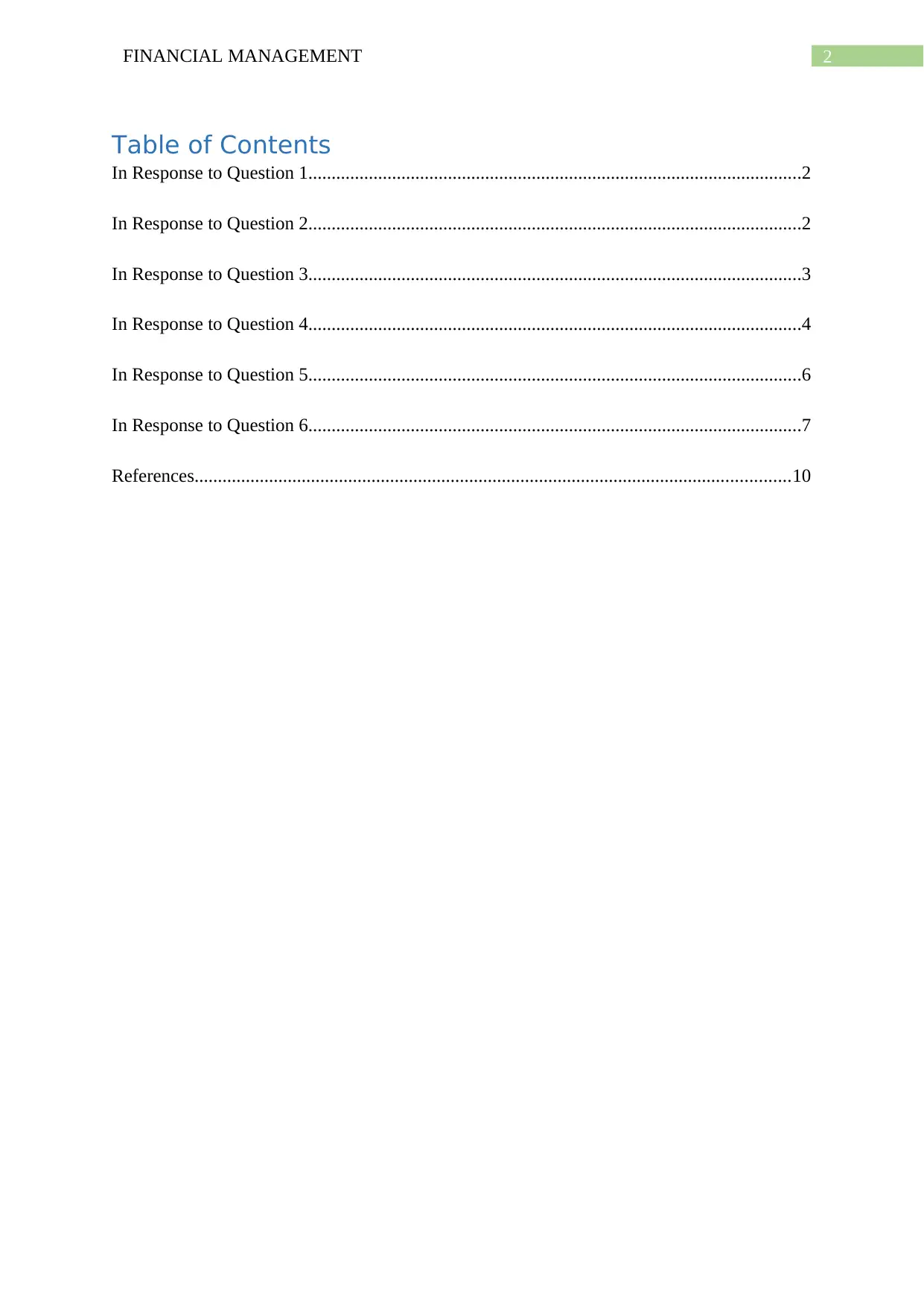
2FINANCIAL MANAGEMENT
Table of Contents
In Response to Question 1..........................................................................................................2
In Response to Question 2..........................................................................................................2
In Response to Question 3..........................................................................................................3
In Response to Question 4..........................................................................................................4
In Response to Question 5..........................................................................................................6
In Response to Question 6..........................................................................................................7
References................................................................................................................................10
Table of Contents
In Response to Question 1..........................................................................................................2
In Response to Question 2..........................................................................................................2
In Response to Question 3..........................................................................................................3
In Response to Question 4..........................................................................................................4
In Response to Question 5..........................................................................................................6
In Response to Question 6..........................................................................................................7
References................................................................................................................................10
⊘ This is a preview!⊘
Do you want full access?
Subscribe today to unlock all pages.

Trusted by 1+ million students worldwide
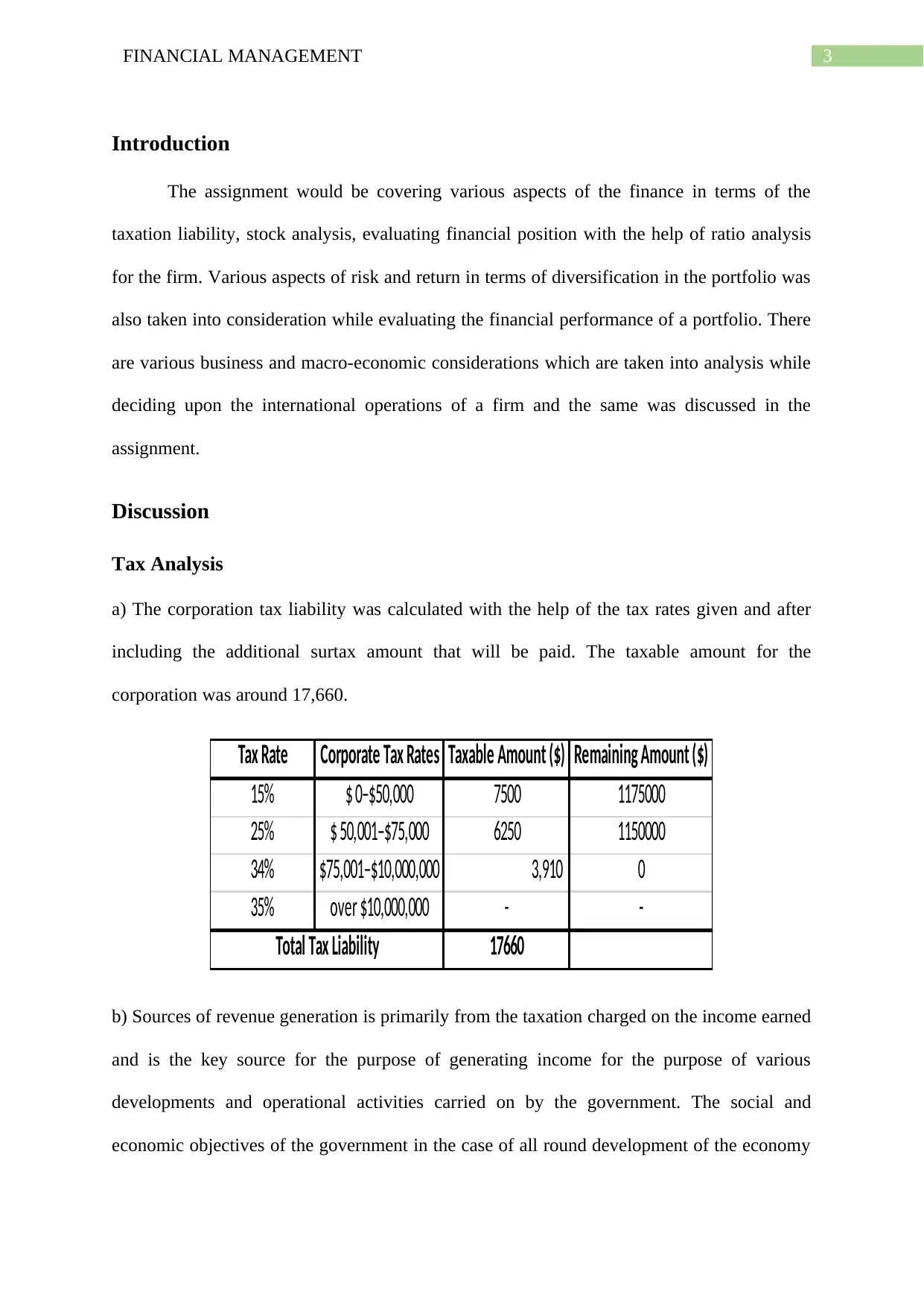
3FINANCIAL MANAGEMENT
Introduction
The assignment would be covering various aspects of the finance in terms of the
taxation liability, stock analysis, evaluating financial position with the help of ratio analysis
for the firm. Various aspects of risk and return in terms of diversification in the portfolio was
also taken into consideration while evaluating the financial performance of a portfolio. There
are various business and macro-economic considerations which are taken into analysis while
deciding upon the international operations of a firm and the same was discussed in the
assignment.
Discussion
Tax Analysis
a) The corporation tax liability was calculated with the help of the tax rates given and after
including the additional surtax amount that will be paid. The taxable amount for the
corporation was around 17,660.
Tax Rate Corporate Tax Rates Taxable Amount ($) Remaining Amount ($)
15% $ 0–$50,000 7500 1175000
25% $ 50,001–$75,000 6250 1150000
34% $75,001–$10,000,000 3,910 0
35% over $10,000,000 - -
17660Total Tax Liability
b) Sources of revenue generation is primarily from the taxation charged on the income earned
and is the key source for the purpose of generating income for the purpose of various
developments and operational activities carried on by the government. The social and
economic objectives of the government in the case of all round development of the economy
Introduction
The assignment would be covering various aspects of the finance in terms of the
taxation liability, stock analysis, evaluating financial position with the help of ratio analysis
for the firm. Various aspects of risk and return in terms of diversification in the portfolio was
also taken into consideration while evaluating the financial performance of a portfolio. There
are various business and macro-economic considerations which are taken into analysis while
deciding upon the international operations of a firm and the same was discussed in the
assignment.
Discussion
Tax Analysis
a) The corporation tax liability was calculated with the help of the tax rates given and after
including the additional surtax amount that will be paid. The taxable amount for the
corporation was around 17,660.
Tax Rate Corporate Tax Rates Taxable Amount ($) Remaining Amount ($)
15% $ 0–$50,000 7500 1175000
25% $ 50,001–$75,000 6250 1150000
34% $75,001–$10,000,000 3,910 0
35% over $10,000,000 - -
17660Total Tax Liability
b) Sources of revenue generation is primarily from the taxation charged on the income earned
and is the key source for the purpose of generating income for the purpose of various
developments and operational activities carried on by the government. The social and
economic objectives of the government in the case of all round development of the economy
Paraphrase This Document
Need a fresh take? Get an instant paraphrase of this document with our AI Paraphraser
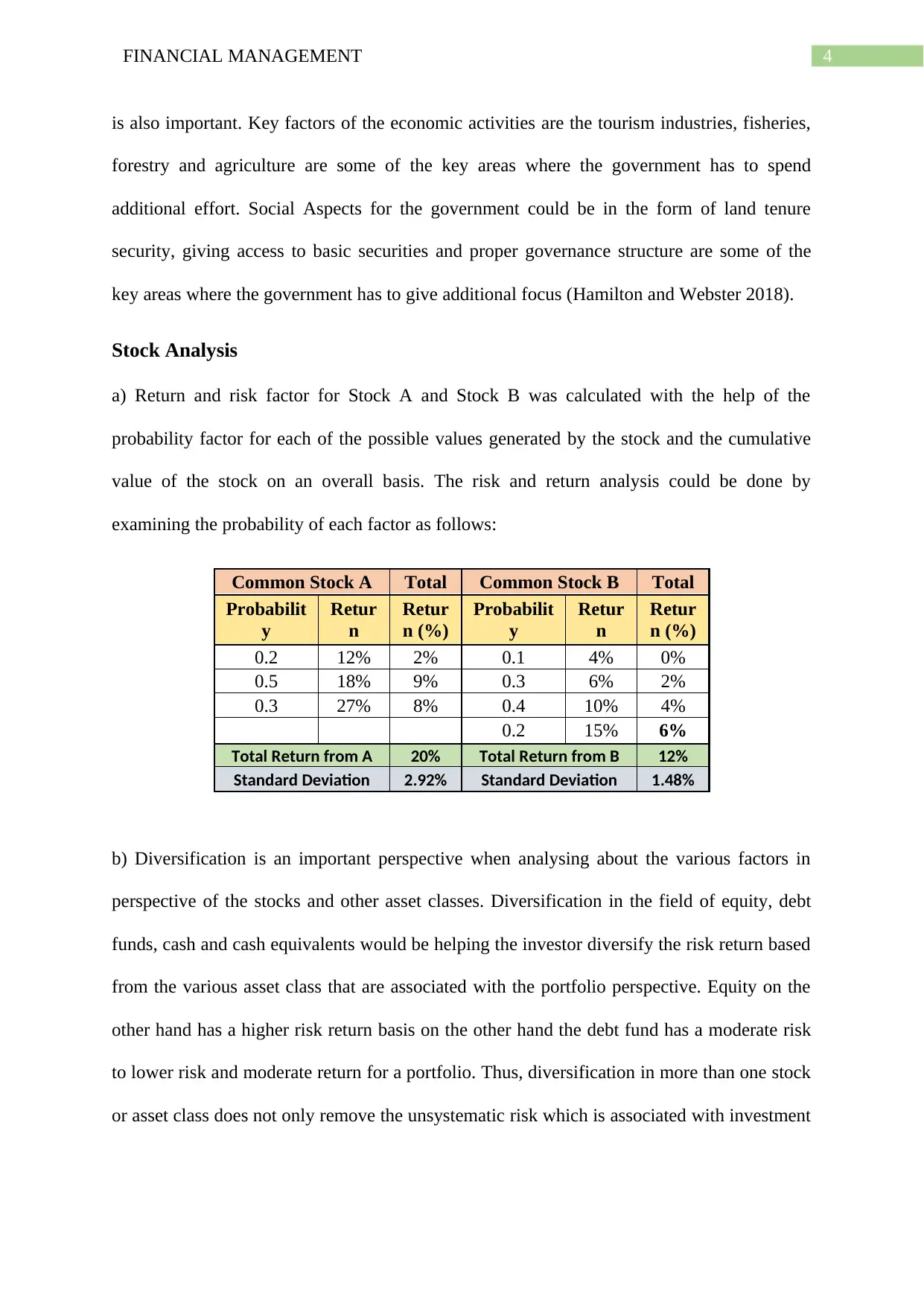
4FINANCIAL MANAGEMENT
is also important. Key factors of the economic activities are the tourism industries, fisheries,
forestry and agriculture are some of the key areas where the government has to spend
additional effort. Social Aspects for the government could be in the form of land tenure
security, giving access to basic securities and proper governance structure are some of the
key areas where the government has to give additional focus (Hamilton and Webster 2018).
Stock Analysis
a) Return and risk factor for Stock A and Stock B was calculated with the help of the
probability factor for each of the possible values generated by the stock and the cumulative
value of the stock on an overall basis. The risk and return analysis could be done by
examining the probability of each factor as follows:
Common Stock A Total Common Stock B Total
Probabilit
y
Retur
n
Retur
n (%)
Probabilit
y
Retur
n
Retur
n (%)
0.2 12% 2% 0.1 4% 0%
0.5 18% 9% 0.3 6% 2%
0.3 27% 8% 0.4 10% 4%
0.2 15% 6%
Total Return from A 20% Total Return from B 12%
Standard Deviation 2.92% Standard Deviation 1.48%
b) Diversification is an important perspective when analysing about the various factors in
perspective of the stocks and other asset classes. Diversification in the field of equity, debt
funds, cash and cash equivalents would be helping the investor diversify the risk return based
from the various asset class that are associated with the portfolio perspective. Equity on the
other hand has a higher risk return basis on the other hand the debt fund has a moderate risk
to lower risk and moderate return for a portfolio. Thus, diversification in more than one stock
or asset class does not only remove the unsystematic risk which is associated with investment
is also important. Key factors of the economic activities are the tourism industries, fisheries,
forestry and agriculture are some of the key areas where the government has to spend
additional effort. Social Aspects for the government could be in the form of land tenure
security, giving access to basic securities and proper governance structure are some of the
key areas where the government has to give additional focus (Hamilton and Webster 2018).
Stock Analysis
a) Return and risk factor for Stock A and Stock B was calculated with the help of the
probability factor for each of the possible values generated by the stock and the cumulative
value of the stock on an overall basis. The risk and return analysis could be done by
examining the probability of each factor as follows:
Common Stock A Total Common Stock B Total
Probabilit
y
Retur
n
Retur
n (%)
Probabilit
y
Retur
n
Retur
n (%)
0.2 12% 2% 0.1 4% 0%
0.5 18% 9% 0.3 6% 2%
0.3 27% 8% 0.4 10% 4%
0.2 15% 6%
Total Return from A 20% Total Return from B 12%
Standard Deviation 2.92% Standard Deviation 1.48%
b) Diversification is an important perspective when analysing about the various factors in
perspective of the stocks and other asset classes. Diversification in the field of equity, debt
funds, cash and cash equivalents would be helping the investor diversify the risk return based
from the various asset class that are associated with the portfolio perspective. Equity on the
other hand has a higher risk return basis on the other hand the debt fund has a moderate risk
to lower risk and moderate return for a portfolio. Thus, diversification in more than one stock
or asset class does not only remove the unsystematic risk which is associated with investment
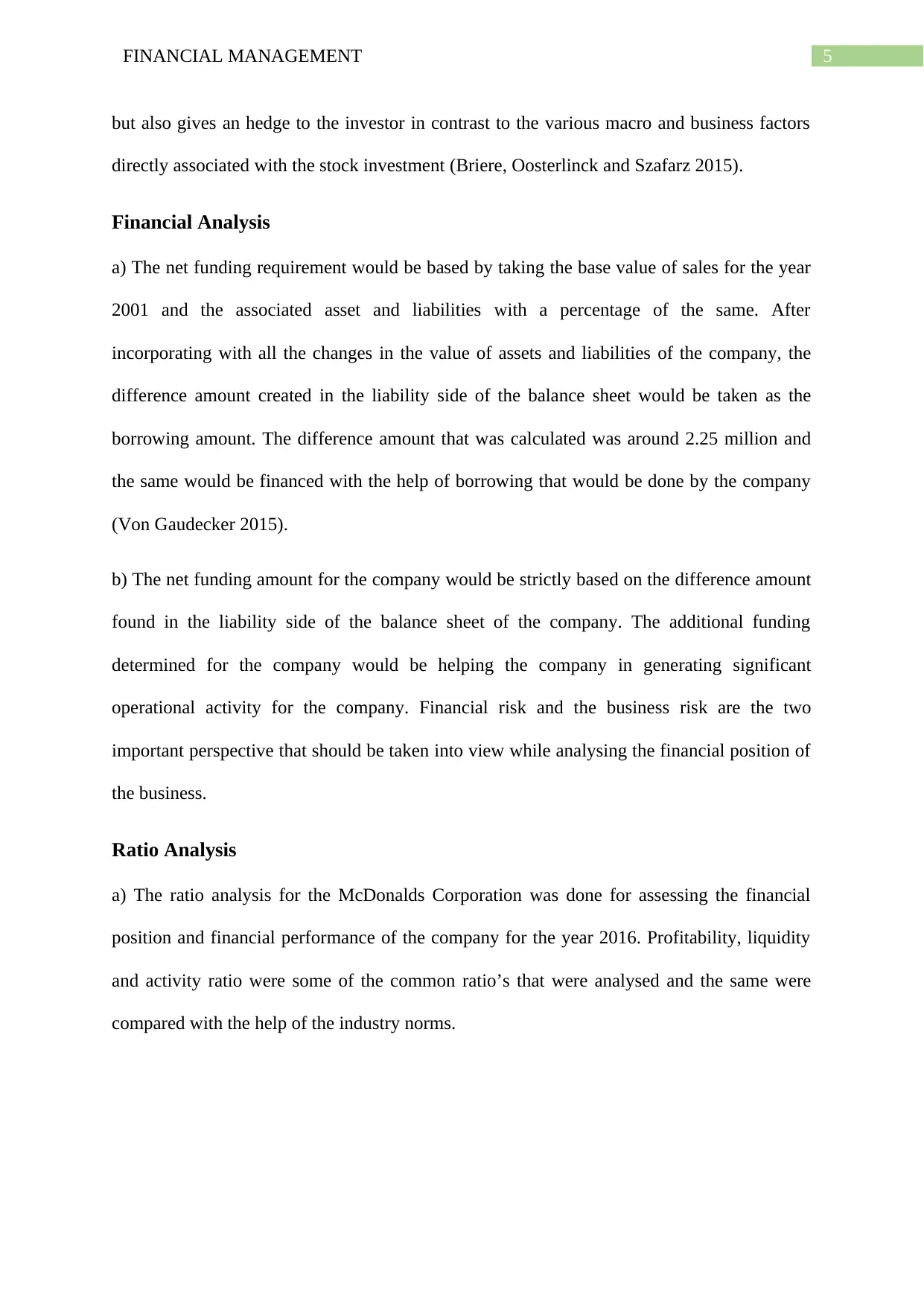
5FINANCIAL MANAGEMENT
but also gives an hedge to the investor in contrast to the various macro and business factors
directly associated with the stock investment (Briere, Oosterlinck and Szafarz 2015).
Financial Analysis
a) The net funding requirement would be based by taking the base value of sales for the year
2001 and the associated asset and liabilities with a percentage of the same. After
incorporating with all the changes in the value of assets and liabilities of the company, the
difference amount created in the liability side of the balance sheet would be taken as the
borrowing amount. The difference amount that was calculated was around 2.25 million and
the same would be financed with the help of borrowing that would be done by the company
(Von Gaudecker 2015).
b) The net funding amount for the company would be strictly based on the difference amount
found in the liability side of the balance sheet of the company. The additional funding
determined for the company would be helping the company in generating significant
operational activity for the company. Financial risk and the business risk are the two
important perspective that should be taken into view while analysing the financial position of
the business.
Ratio Analysis
a) The ratio analysis for the McDonalds Corporation was done for assessing the financial
position and financial performance of the company for the year 2016. Profitability, liquidity
and activity ratio were some of the common ratio’s that were analysed and the same were
compared with the help of the industry norms.
but also gives an hedge to the investor in contrast to the various macro and business factors
directly associated with the stock investment (Briere, Oosterlinck and Szafarz 2015).
Financial Analysis
a) The net funding requirement would be based by taking the base value of sales for the year
2001 and the associated asset and liabilities with a percentage of the same. After
incorporating with all the changes in the value of assets and liabilities of the company, the
difference amount created in the liability side of the balance sheet would be taken as the
borrowing amount. The difference amount that was calculated was around 2.25 million and
the same would be financed with the help of borrowing that would be done by the company
(Von Gaudecker 2015).
b) The net funding amount for the company would be strictly based on the difference amount
found in the liability side of the balance sheet of the company. The additional funding
determined for the company would be helping the company in generating significant
operational activity for the company. Financial risk and the business risk are the two
important perspective that should be taken into view while analysing the financial position of
the business.
Ratio Analysis
a) The ratio analysis for the McDonalds Corporation was done for assessing the financial
position and financial performance of the company for the year 2016. Profitability, liquidity
and activity ratio were some of the common ratio’s that were analysed and the same were
compared with the help of the industry norms.
⊘ This is a preview!⊘
Do you want full access?
Subscribe today to unlock all pages.

Trusted by 1+ million students worldwide

6FINANCIAL MANAGEMENT
Ratio Analysis in the books of McDonald's Corporation
Ratio Analysis in the books of McDonald's Corporation
Paraphrase This Document
Need a fresh take? Get an instant paraphrase of this document with our AI Paraphraser

7FINANCIAL MANAGEMENT
Particulars Amt
Current Assets 1143
Current Liabilities 2985
Current Ratio (Current Assets/Current Liability) 0.38
Cost of Goods Sold 6537
Inventory 71
Inventory Turnover Ratio (COGS/Inventory) 92
Sales
1150
8
Accounts Receivable 484
Accounts Receivable Turnover (Sales/Accounts Recvble) 24
365 Days 365
Accounts Receivable Turnover 24
Average Collection Period (365/Accounts Receivable Turnover) 15.35
Total Liabilities 9310
Total Assets
1824
2
Debt Ratio (Total Liabilities/Total Assets) 0.51
Sales
1150
8
Total Assets
1824
2
Total Assets Turnover (Sales/Total Assets) 0.63
Sales
1150
8
Fixed Assets
1496
1
Total Fixed Assets Turnover (Sales/Total Fixed Assets) 0.77
Operating Profit 2794
Sales
1150
8
Operating Profit Margin (Operating Profit/Sales) 24%
Net Profit 1642
Total Shareholder's Equity 8852
Return on Common Equity (Net Profit/Equity Shareholder's) 19%
Particulars Amt
Current Assets 1143
Current Liabilities 2985
Current Ratio (Current Assets/Current Liability) 0.38
Cost of Goods Sold 6537
Inventory 71
Inventory Turnover Ratio (COGS/Inventory) 92
Sales
1150
8
Accounts Receivable 484
Accounts Receivable Turnover (Sales/Accounts Recvble) 24
365 Days 365
Accounts Receivable Turnover 24
Average Collection Period (365/Accounts Receivable Turnover) 15.35
Total Liabilities 9310
Total Assets
1824
2
Debt Ratio (Total Liabilities/Total Assets) 0.51
Sales
1150
8
Total Assets
1824
2
Total Assets Turnover (Sales/Total Assets) 0.63
Sales
1150
8
Fixed Assets
1496
1
Total Fixed Assets Turnover (Sales/Total Fixed Assets) 0.77
Operating Profit 2794
Sales
1150
8
Operating Profit Margin (Operating Profit/Sales) 24%
Net Profit 1642
Total Shareholder's Equity 8852
Return on Common Equity (Net Profit/Equity Shareholder's) 19%
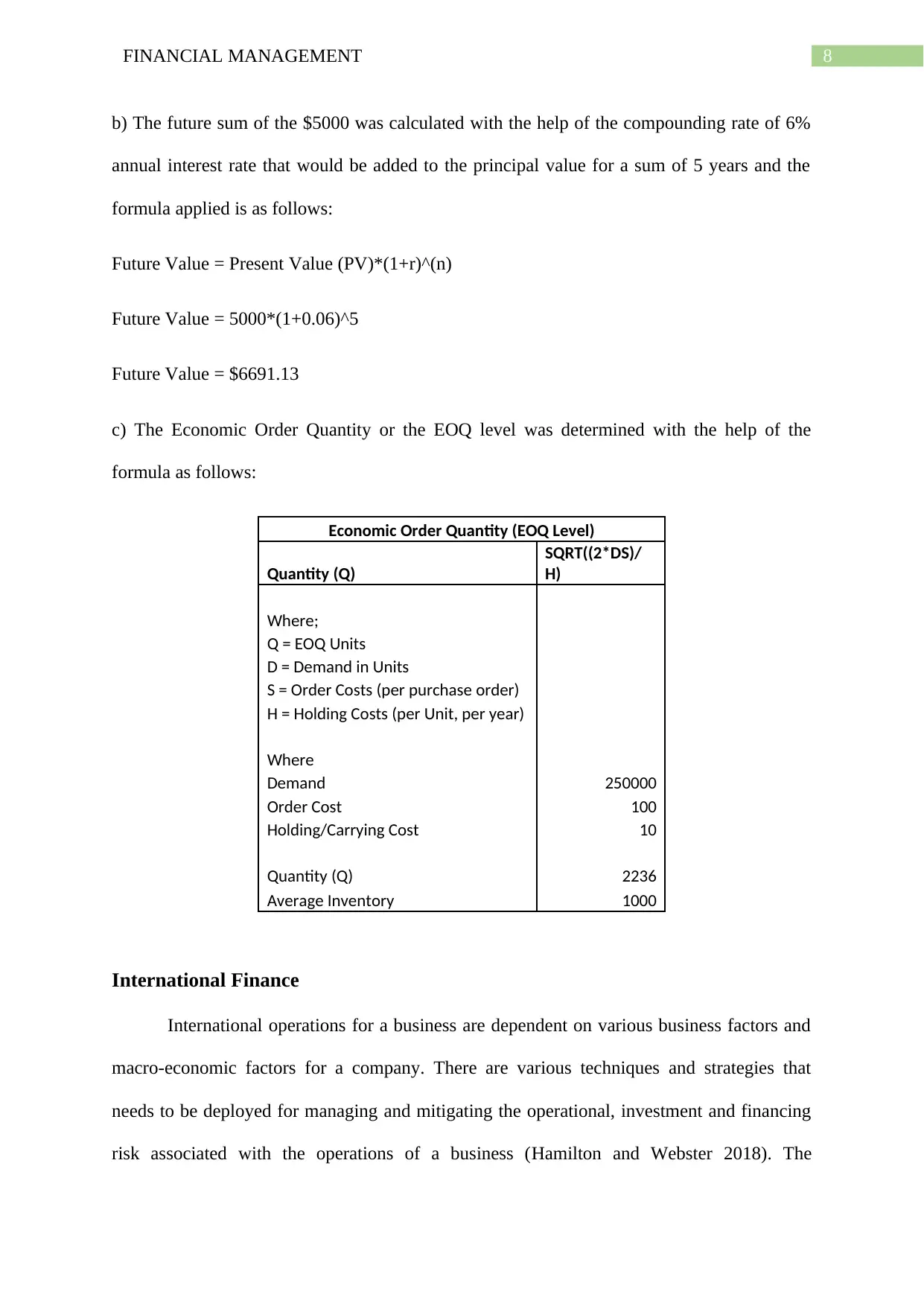
8FINANCIAL MANAGEMENT
b) The future sum of the $5000 was calculated with the help of the compounding rate of 6%
annual interest rate that would be added to the principal value for a sum of 5 years and the
formula applied is as follows:
Future Value = Present Value (PV)*(1+r)^(n)
Future Value = 5000*(1+0.06)^5
Future Value = $6691.13
c) The Economic Order Quantity or the EOQ level was determined with the help of the
formula as follows:
Economic Order Quantity (EOQ Level)
Quantity (Q)
SQRT((2*DS)/
H)
Where;
Q = EOQ Units
D = Demand in Units
S = Order Costs (per purchase order)
H = Holding Costs (per Unit, per year)
Where
Demand 250000
Order Cost 100
Holding/Carrying Cost 10
Quantity (Q) 2236
Average Inventory 1000
International Finance
International operations for a business are dependent on various business factors and
macro-economic factors for a company. There are various techniques and strategies that
needs to be deployed for managing and mitigating the operational, investment and financing
risk associated with the operations of a business (Hamilton and Webster 2018). The
b) The future sum of the $5000 was calculated with the help of the compounding rate of 6%
annual interest rate that would be added to the principal value for a sum of 5 years and the
formula applied is as follows:
Future Value = Present Value (PV)*(1+r)^(n)
Future Value = 5000*(1+0.06)^5
Future Value = $6691.13
c) The Economic Order Quantity or the EOQ level was determined with the help of the
formula as follows:
Economic Order Quantity (EOQ Level)
Quantity (Q)
SQRT((2*DS)/
H)
Where;
Q = EOQ Units
D = Demand in Units
S = Order Costs (per purchase order)
H = Holding Costs (per Unit, per year)
Where
Demand 250000
Order Cost 100
Holding/Carrying Cost 10
Quantity (Q) 2236
Average Inventory 1000
International Finance
International operations for a business are dependent on various business factors and
macro-economic factors for a company. There are various techniques and strategies that
needs to be deployed for managing and mitigating the operational, investment and financing
risk associated with the operations of a business (Hamilton and Webster 2018). The
⊘ This is a preview!⊘
Do you want full access?
Subscribe today to unlock all pages.

Trusted by 1+ million students worldwide
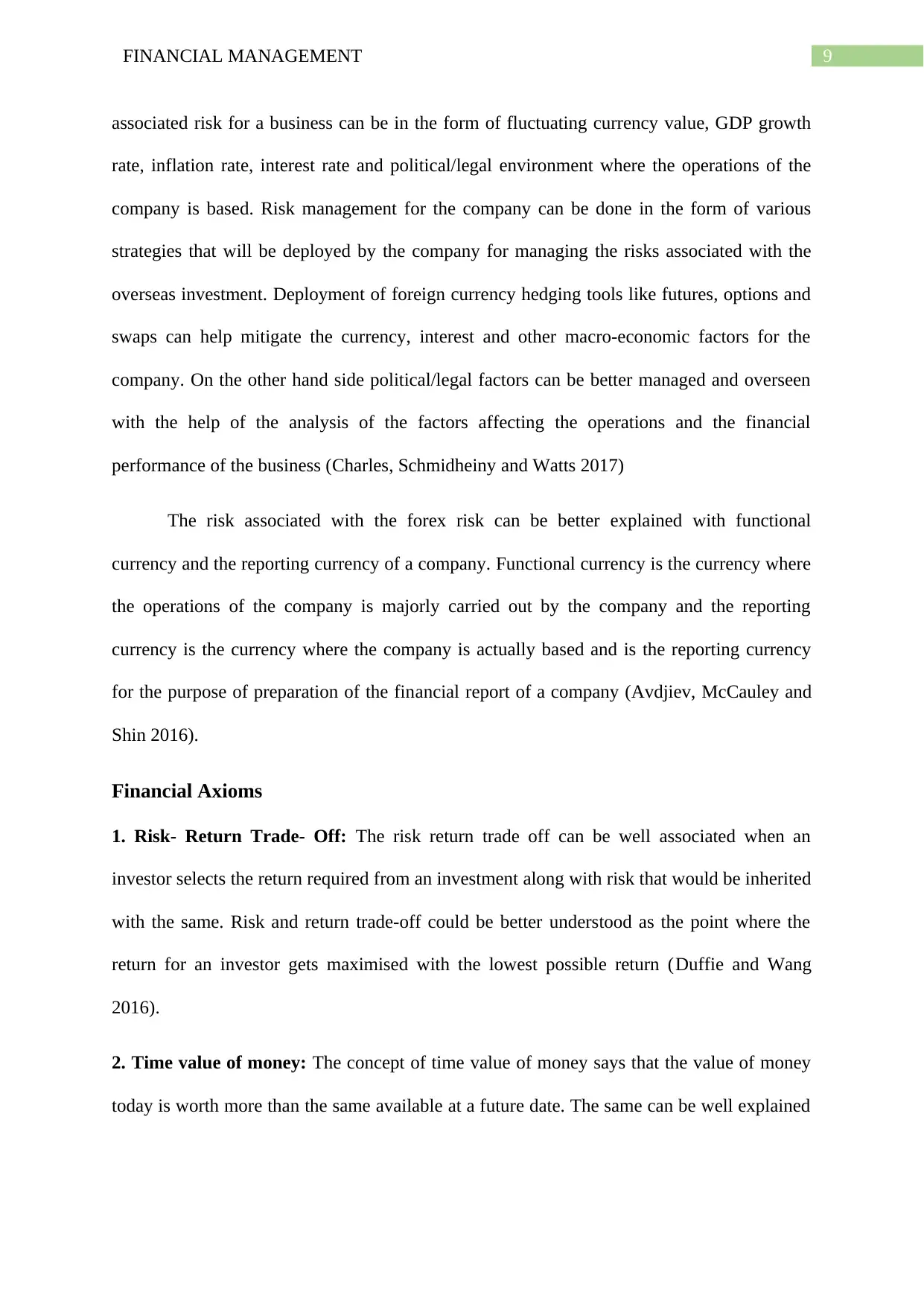
9FINANCIAL MANAGEMENT
associated risk for a business can be in the form of fluctuating currency value, GDP growth
rate, inflation rate, interest rate and political/legal environment where the operations of the
company is based. Risk management for the company can be done in the form of various
strategies that will be deployed by the company for managing the risks associated with the
overseas investment. Deployment of foreign currency hedging tools like futures, options and
swaps can help mitigate the currency, interest and other macro-economic factors for the
company. On the other hand side political/legal factors can be better managed and overseen
with the help of the analysis of the factors affecting the operations and the financial
performance of the business (Charles, Schmidheiny and Watts 2017)
The risk associated with the forex risk can be better explained with functional
currency and the reporting currency of a company. Functional currency is the currency where
the operations of the company is majorly carried out by the company and the reporting
currency is the currency where the company is actually based and is the reporting currency
for the purpose of preparation of the financial report of a company (Avdjiev, McCauley and
Shin 2016).
Financial Axioms
1. Risk- Return Trade- Off: The risk return trade off can be well associated when an
investor selects the return required from an investment along with risk that would be inherited
with the same. Risk and return trade-off could be better understood as the point where the
return for an investor gets maximised with the lowest possible return (Duffie and Wang
2016).
2. Time value of money: The concept of time value of money says that the value of money
today is worth more than the same available at a future date. The same can be well explained
associated risk for a business can be in the form of fluctuating currency value, GDP growth
rate, inflation rate, interest rate and political/legal environment where the operations of the
company is based. Risk management for the company can be done in the form of various
strategies that will be deployed by the company for managing the risks associated with the
overseas investment. Deployment of foreign currency hedging tools like futures, options and
swaps can help mitigate the currency, interest and other macro-economic factors for the
company. On the other hand side political/legal factors can be better managed and overseen
with the help of the analysis of the factors affecting the operations and the financial
performance of the business (Charles, Schmidheiny and Watts 2017)
The risk associated with the forex risk can be better explained with functional
currency and the reporting currency of a company. Functional currency is the currency where
the operations of the company is majorly carried out by the company and the reporting
currency is the currency where the company is actually based and is the reporting currency
for the purpose of preparation of the financial report of a company (Avdjiev, McCauley and
Shin 2016).
Financial Axioms
1. Risk- Return Trade- Off: The risk return trade off can be well associated when an
investor selects the return required from an investment along with risk that would be inherited
with the same. Risk and return trade-off could be better understood as the point where the
return for an investor gets maximised with the lowest possible return (Duffie and Wang
2016).
2. Time value of money: The concept of time value of money says that the value of money
today is worth more than the same available at a future date. The same can be well explained
Paraphrase This Document
Need a fresh take? Get an instant paraphrase of this document with our AI Paraphraser

10FINANCIAL MANAGEMENT
with the help of loss of potential value of a money with rising i8nterets rate and inflation rate
in the economy (Talmor 2018).
3. Cash is King: Liquidity is one such factor that ensures that the operations of the business
are carried out well with the help of the adequate cash that is maintained that by the company.
Adequate cash ensures that the operations of the company are carried out well and the
company is able to pay off with the current obligations of the company on a timely manner
(Chambers, Echenique and Saito 2016).
4. Incremental Cash Flows: The incremental cash inflows can be in the form of higher
earnings for the company and the same could be well because of the higher revenue or
optimum utilization of resources for the company thereby reducing the cost for the company
(Chan and Rate 2018). Incremental cash outflows for the company on the other hand could be
in the form of higher initial investment or the costs associated with the project that the
company pays while associated with the project and the same increase the overall total cash
outflows for the company. Thus incremental cash flows for a company can be both on the
basis of cash inflows and cash outflows for a firm depending upon the situation and the
factors associated with the project.
5. Agency Problem: Agency problem arises usually when there is a problem between the
shareholders and the management of the company and the same can be because of the
operational and investment activities carried out by the management of the company (Hamza
and Jedidia 2017). Agency problem can also be related as a conflict between the shareholders
and the management of a company. However, the solution for the same is when the
management of the company carries on activities in accordance with the policy of the
company.
with the help of loss of potential value of a money with rising i8nterets rate and inflation rate
in the economy (Talmor 2018).
3. Cash is King: Liquidity is one such factor that ensures that the operations of the business
are carried out well with the help of the adequate cash that is maintained that by the company.
Adequate cash ensures that the operations of the company are carried out well and the
company is able to pay off with the current obligations of the company on a timely manner
(Chambers, Echenique and Saito 2016).
4. Incremental Cash Flows: The incremental cash inflows can be in the form of higher
earnings for the company and the same could be well because of the higher revenue or
optimum utilization of resources for the company thereby reducing the cost for the company
(Chan and Rate 2018). Incremental cash outflows for the company on the other hand could be
in the form of higher initial investment or the costs associated with the project that the
company pays while associated with the project and the same increase the overall total cash
outflows for the company. Thus incremental cash flows for a company can be both on the
basis of cash inflows and cash outflows for a firm depending upon the situation and the
factors associated with the project.
5. Agency Problem: Agency problem arises usually when there is a problem between the
shareholders and the management of the company and the same can be because of the
operational and investment activities carried out by the management of the company (Hamza
and Jedidia 2017). Agency problem can also be related as a conflict between the shareholders
and the management of a company. However, the solution for the same is when the
management of the company carries on activities in accordance with the policy of the
company.
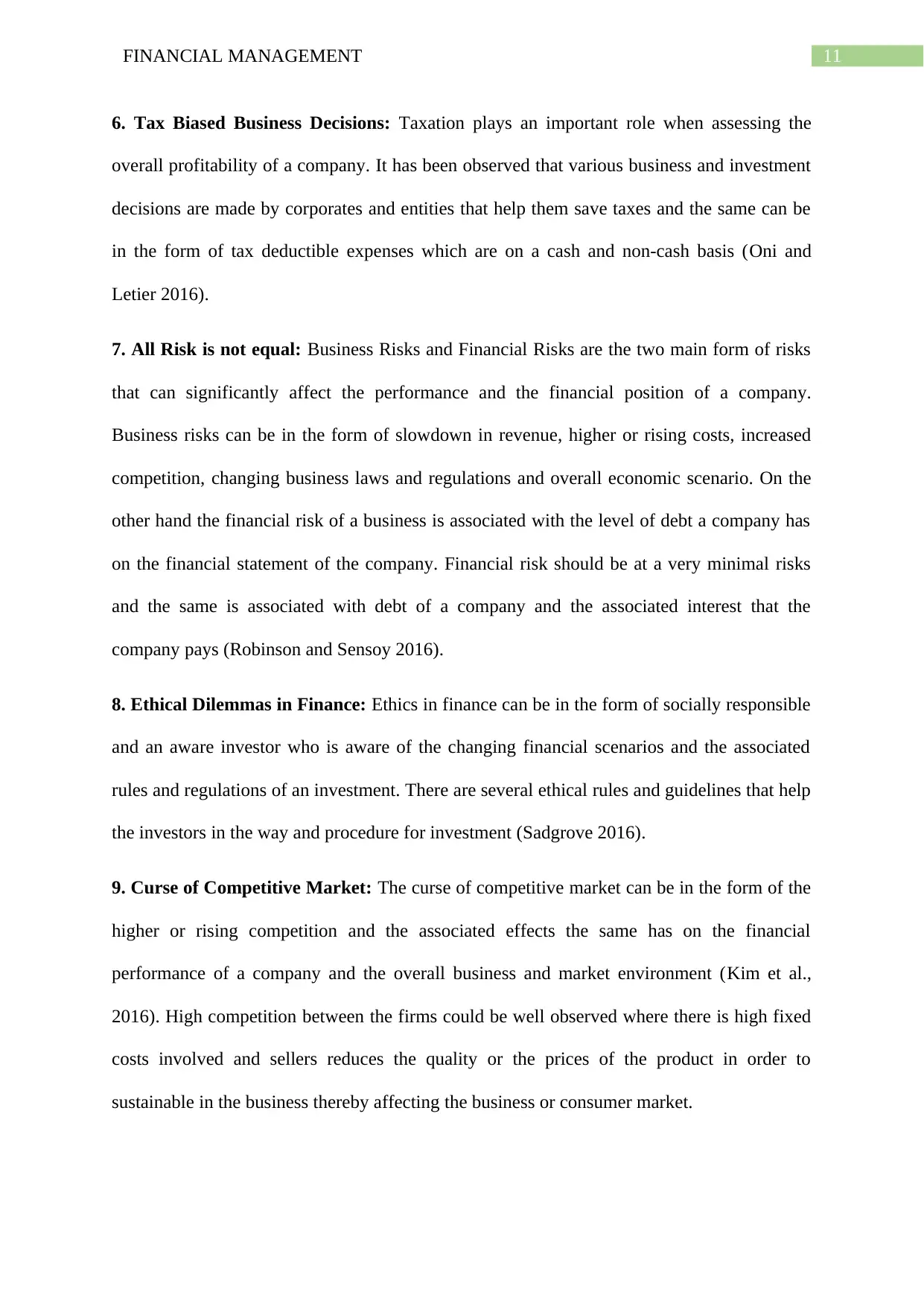
11FINANCIAL MANAGEMENT
6. Tax Biased Business Decisions: Taxation plays an important role when assessing the
overall profitability of a company. It has been observed that various business and investment
decisions are made by corporates and entities that help them save taxes and the same can be
in the form of tax deductible expenses which are on a cash and non-cash basis (Oni and
Letier 2016).
7. All Risk is not equal: Business Risks and Financial Risks are the two main form of risks
that can significantly affect the performance and the financial position of a company.
Business risks can be in the form of slowdown in revenue, higher or rising costs, increased
competition, changing business laws and regulations and overall economic scenario. On the
other hand the financial risk of a business is associated with the level of debt a company has
on the financial statement of the company. Financial risk should be at a very minimal risks
and the same is associated with debt of a company and the associated interest that the
company pays (Robinson and Sensoy 2016).
8. Ethical Dilemmas in Finance: Ethics in finance can be in the form of socially responsible
and an aware investor who is aware of the changing financial scenarios and the associated
rules and regulations of an investment. There are several ethical rules and guidelines that help
the investors in the way and procedure for investment (Sadgrove 2016).
9. Curse of Competitive Market: The curse of competitive market can be in the form of the
higher or rising competition and the associated effects the same has on the financial
performance of a company and the overall business and market environment (Kim et al.,
2016). High competition between the firms could be well observed where there is high fixed
costs involved and sellers reduces the quality or the prices of the product in order to
sustainable in the business thereby affecting the business or consumer market.
6. Tax Biased Business Decisions: Taxation plays an important role when assessing the
overall profitability of a company. It has been observed that various business and investment
decisions are made by corporates and entities that help them save taxes and the same can be
in the form of tax deductible expenses which are on a cash and non-cash basis (Oni and
Letier 2016).
7. All Risk is not equal: Business Risks and Financial Risks are the two main form of risks
that can significantly affect the performance and the financial position of a company.
Business risks can be in the form of slowdown in revenue, higher or rising costs, increased
competition, changing business laws and regulations and overall economic scenario. On the
other hand the financial risk of a business is associated with the level of debt a company has
on the financial statement of the company. Financial risk should be at a very minimal risks
and the same is associated with debt of a company and the associated interest that the
company pays (Robinson and Sensoy 2016).
8. Ethical Dilemmas in Finance: Ethics in finance can be in the form of socially responsible
and an aware investor who is aware of the changing financial scenarios and the associated
rules and regulations of an investment. There are several ethical rules and guidelines that help
the investors in the way and procedure for investment (Sadgrove 2016).
9. Curse of Competitive Market: The curse of competitive market can be in the form of the
higher or rising competition and the associated effects the same has on the financial
performance of a company and the overall business and market environment (Kim et al.,
2016). High competition between the firms could be well observed where there is high fixed
costs involved and sellers reduces the quality or the prices of the product in order to
sustainable in the business thereby affecting the business or consumer market.
⊘ This is a preview!⊘
Do you want full access?
Subscribe today to unlock all pages.

Trusted by 1+ million students worldwide
1 out of 15
Related Documents
Your All-in-One AI-Powered Toolkit for Academic Success.
+13062052269
info@desklib.com
Available 24*7 on WhatsApp / Email
![[object Object]](/_next/static/media/star-bottom.7253800d.svg)
Unlock your academic potential
Copyright © 2020–2025 A2Z Services. All Rights Reserved. Developed and managed by ZUCOL.





